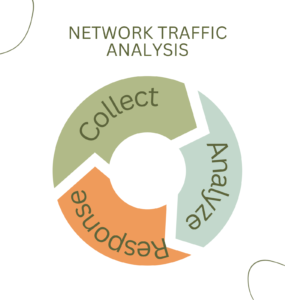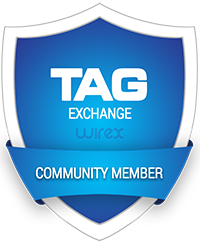November 5 2022 |
In the modern cyberattack landscape, threats are everywhere and your organization can be a victim. This is not only costly but can also affect your company’s reputation and revenue. Cybercrime cost businesses in the US over $6.9 billion in 2021, and only 43 percent of businesses reported that they are financially prepared to handle a cyber-attack in 2022.
So how can you prevent your company from such attacks?
An effective way to prevent these attacks is to keep a close eye on your enterprise network and analyze its traffic. Network traffic analysis (NTA) is a technique for inspecting and analyzing the data packets that makeup network traffic. Cybersecurity teams can use NTA to identify irregularities or suspicious activities and respond early enough to protect the network and organization as a whole.
In this article, we’ll cover:
- What Network Traffic Analysis (NTA) is
- How it works
- Why it’s important for companies
- Benefits, disadvantages, and best practices
- Best NTA tools in the market
What Is Network Traffic Analysis (NTA)?
Network Traffic Analysis (NTA) is a method of collecting, analyzing, and reporting on network traffic data to understand how the network is being used, identify key trends and patterns, and detect anomalies and security threats. NTA uses machine learning and rule-based algorithms to help security teams spot anything unusual or dangerous that may affect your network. This helps them to plan the actions to take to prevent such attacks before they cause serious damage.
NTA can be performed on several types of networks, including wide area networks (WANs), local area networks (LANs), and the internet. For real-time updates on what’s happening, traffic data is gathered in or close to real-time. This allows security teams to act quickly in the event of a problem.

How Does It Work?
To perform NTA, administrators typically use specialized software solutions or network monitoring platforms that can collect, analyze, and report on traffic data in real time or over a period of time. These tools can analyze both east/west and north/south traffic to get constant, real-time visibility into a company’s network, identify traffic patterns and behaviors, and improve their capabilities in threat detection and response.
Several different tools and techniques can be used to perform network traffic analysis (NTA). Some common techniques include:
Packet Capture: This process involves capturing and storing a copy of all the packets of data that are transmitted over the network. These packets can then be analyzed to understand how the network is being used, identify trends and patterns, and detect anomalies or security threats.
Flow Analysis: In this process, the traffic flow between different devices or network segments is analyzed to help administrators to identify patterns and trends in network usage, as well as identify potential bottlenecks or other performance issues.
Log Analysis: This involves analyzing log files generated by network devices, such as switches, routers, and servers. These logs can provide valuable information about the traffic flowing through the network, including potential security incidents that may have occurred.
Once the data is gathered and analyzed, security and network professionals can use the findings from NTA to identify and address security issues, detect and respond to threats, and optimize network performance.
Why Is It Important, And How Does It Improve Your Security?
Keeping a close eye on your network system is key, even when you have firewalls in place, mistakes can happen and rogue traffic could get through.
Here are some reasons why NTA is important for your organization.
It Provides Valuable Insights For Network Performance
As a result of the growing adoption of the Internet of Things, DevOps practices, and cloud computing, maintaining good network performance and visibility has become a challenge.
NTA can help identify bottlenecks and other issues that may be affecting network performance. Network Traffic acts as a single source of truth for the organization since they observe everything and provide objective facts that other data sources often struggle to give. This allows organizations to optimize their network infrastructure and improve overall efficiency.
Gives Your Company An Enhanced Security Posture
An NTA solution can help identify security threats by analyzing network traffic for signs of malicious activity, such as unusual patterns of traffic, known malware, or unauthorized access attempts.
They can spot things like large downloads, streaming, or even suspicious inbound or outbound traffic and notify teams of them before they cause serious damage.
It Automatically Detects Anomalies
Since NTA monitors laterally across multi-cloud environments providing security teams with real-time insights, it’s able to detect and diagnose anomalous activities and malicious behaviors including security and operational issues.
It uses network communications with a combination of machine learning, behavioral modeling, and rule-based detection to continuously analyze flow records or network, then notifies the security team of potential threats when irregular activities or traffic patterns are detected in the network.
Benefits Of NTA
Businesses of all sizes use NTA tools to improve network management and strengthen their infrastructure and security posture. Here is why security professionals and systems administrators should be using NTA daily.
Enhanced Security: Efficient NTA tools make an organization appear more trustworthy and committed to offering more effective services. NTA can help identify security threats by analyzing network traffic for signs of malicious activity, such as unusual patterns of traffic, known malware, or unauthorized access attempts. This attracts customers and discourages hackers from trying to get into your company.
Robust Network Performance: NTA enables companies to identify potential areas that are prone to attacks and adjust and boost productivity to prevent problems. This helps security teams optimize their network infrastructure and improve overall efficiency.
Improved Efficiency: For most IT teams, it’s impractical to maintain constant active monitoring of network traffic. Organizations can use NTA to gain visibility into their network to better understand their network usage patterns and optimize resources accordingly.
Improved Compliance: NTA can help companies comply with various regulations and standards, such as HIPAA or PCI DSS, by providing the necessary data and documentation to demonstrate compliance.
Disadvantages Of NTA
Like every technology, NTA has its disadvantages. Here are some weaknesses found when using network traffic analysis:
Cost And Complexity
NTA services retain data in packets which means that organizations need to purchase devices such as packet-filtering firewalls, load balancers, and storage devices. These not only increase organizations’ costs but are also complex to manage, requiring specialized knowledge and tools to interpret and analyze the data.
Data Handling And Storage
Data comes from different sources and moves in different forms (flow data and packet data), which makes it difficult for NTA solutions to handle these types of data.
Processing Intensive
NTA analysis can be resource-intensive, requiring significant processing power and storage capacity to analyze large volumes of data in real time.

WireX Systems
WireX Systems is a next-generation NTA tool that provides real-time visibility into network traffic and can identify potential security threats. It uses machine learning and behavioral analysis to identify anomalies and unusual activity and can provide detailed forensic data for threat detection and response. WireX is designed to be easy to use and scalable, making it suitable for use in a wide range of environments.
NTA Best Practices
Collecting the data needed to properly analyze your network traffic can be hard because you need to store a lot of it. But there are some best practices you can follow to make the process easier.
You Must Know Your Network
It’s important to have a detailed understanding of your network infrastructure, including the devices, systems, and applications that make up the network. NTA allows you to have a clear understanding of your network including systems, devices, and applications. For example, if you know that a certain server or device should only be communicating with a small number of other servers or devices, you can set up alerts or rules to flag any traffic from that device to an unexpected destination as potentially suspicious.
This allows you to monitor and analyze traffic, identify potential threats, and maintain the security and integrity of your network.
Implement Integrations To Optimize Response Time
Implementing integrations in the context of network traffic analysis (NTA) refers to the process of connecting different tools and systems to automate and streamline certain processes related to analyzing network traffic. This allows different systems to communicate and exchange data more efficiently, reducing the need for manual data entry and other manual tasks that can slow down the response time.
Integrating your NTA tools with other security systems, such as firewalls, intrusion detection systems, and security information and event management (SIEM) systems, can help optimize response time and improve overall security. This can help organizations to more effectively monitor and analyze their network traffic, identify potential threats or issues, and take appropriate action to protect their networks and systems.
Automation Is Your Friend
Automating some aspects of your NTA process, such as data collection and analysis, can help to improve efficiency and reduce the risk of human error.
This means that organizations can help improve the accuracy and consistency of NTA tasks, as automated processes are less prone to error compared to manual ones. Also, automation can also help to improve the efficiency of NTA processes, allowing organizations to respond more quickly to potential threats or issues.
For instance, an organization might automatically collect and analyze data related to network traffic and send alerts when potential threats or issues are identified. This can help to reduce the workload of network and security NTA teams and allow them to focus on more complex and personalized tasks related to analyzing and responding to network traffic.
Threat Detection Should Be A Priority
Implementing NTA tools and techniques with threat detection in mind can help you identify and respond to potential threats more quickly. Coupled with multiple sources of information to detect threats including firewall logs, intrusion detection systems (IDS), security information and event management (SIEM) systems, and threat intelligence feeds can create a powerful combination. By using multiple sources of intelligence, you can get a more comprehensive view of the threat landscape and increase the chances of detecting threats.
Threats can evolve quickly, so it’s important to analyze network traffic in real time to catch threats as they happen. This can be enhanced using tools such as SIEM systems or network-based intrusion detection systems (NIDS). Ensuring that there is continuous monitoring and updating of threat detection capabilities to improve their effectiveness. This may involve regularly updating your intelligence sources, implementing new detection technologies, and fine-tuning your response plan.
Setting Correctly Cybersecurity Policies
Establishing and enforcing clear cybersecurity policies can help ensure that your NTA efforts are aligned with your overall security goals and objectives. These policies can cover a wide range of topics, including password management, data handling and storage, network security, and incident response procedures.
By setting clear cybersecurity policies, organizations can help to prevent security breaches and protect against cyber threats. This, in turn, can help protect the organization’s sensitive data and maintain the trust of customers, clients, and other stakeholders. These policies should be reviewed and updated regularly to ensure they are effective and relevant.
Why Should I Integrate NTA Into My Company?
NTA monitors, analyzes, and reports network traffic to understand the usage and behavior of networks connected to them. There are several reasons why your company might want to integrate NTA into your operations including:
- Enhance security to help identify unusual or suspicious activity on the network, such as malware infections or attempts to access unauthorized resources. This can allow the company to take timely action to prevent or mitigate security threats.
- Improve performance to discover bottlenecks or other performance issues on the network, so that the company can address them in a timely manner
- Provide visibility into the usage and behavior of the network and connected devices, allowing your company to better understand and optimize its operations.
The Right Solution To Perform Network Traffic Analysis
NTA allows organizations to monitor network activities to identify vulnerabilities, optimize performance, and prevent cyber-attack attempts. When choosing the right NTA solution for your organization, ensure you understand the current problems in your network and the sources that you want to gain insights from.
WireX Systems’ network detection and response leverages the Contextual Capture technology to fully monitor your network environment. It allows you to gain visibility into your network and reconstruct the raw data into a simple format that the security teams at all levels can comprehend and act upon.
Want to improve your company’s security system and prevent any more cyberattacks? Contact our team of experts to see how they can help you handle more threats fast and effectively.






